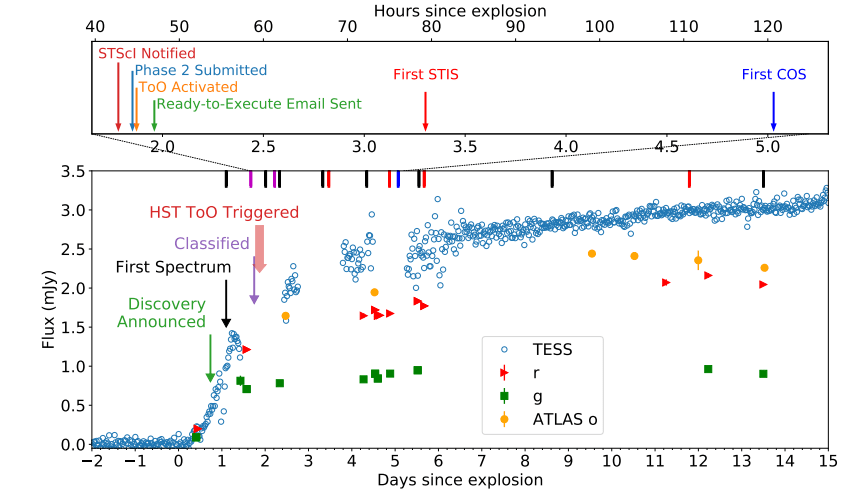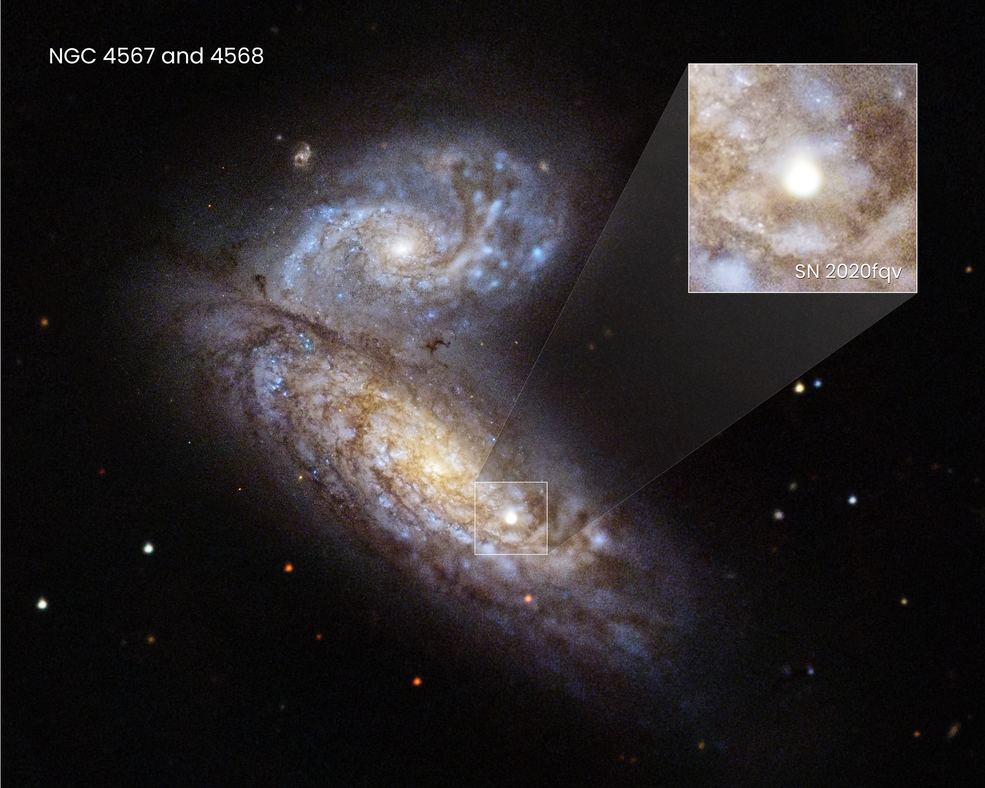If it weren’t for supernova remnants we wouldn’t have much knowledge of supernovae themselves. If a supernova explosion is the end of a star’s life, then we can also thank forensic astrophysics for much of our knowledge. The massive exploding stars leave behind brilliant and mesmerizing evidence of their catastrophic ends, and much of what we know about supernovae comes from studying the remnants rather than the explosions themselves. Supernova remnants like the Crab Nebula and SN 1604 (Kepler’s Supernova) are some of our most-studied objects.
Observing an active supernova in the grip of its own destruction can be difficult. But it looks like the Hubble Space Telescope is up to the task.
Recently, a team of scientists used Hubble data, along with other observations, to give us a detailed view of the beginning of the end of one massive star going supernova. It’s called SN 2020fqv, and it’s about 60 million light-years away in what’s known as the Interacting Butterfly Galaxies (NGC 4567 and NGC 4568.)
The team published their findings in a paper titled “Progenitor and close-in Circumstellar Medium of Type II Supernova 2020fqv from high-cadence photometry and ultra-rapid UV spectroscopy.” It’s published in the Monthly Notices of the Royal Astronomical Society. The lead author is Samaporn Tinyanont, a post-Doctoral scholar at UC Santa Cruz.
The exploding star was first spotted by the Zwicky Transient Facility, and astronomers also realized that NASA’s TESS (Transient Exoplanet Survey Satellite) was observing the supernova, which happened to be in the satellite’s active observing area. While both these facilities are good at finding things like supernovae, they’re not great at studying them in detail. (TESS’s main job is finding exoplanets, but it’s spotted many supernovae. In fact, in a paper published a year ago, astronomers predicted that TESS might play a role in detecting a supernova in these early stages of destruction.) Supernovae explosions are a big deal in the astronomy/astrophysics world, so astronomers rushed to point the Hubble and other ground-based facilities at SN 2020fqv.
This turned out to be a very fortunate occurrence. Astronomers were able to see the star in its earliest stages of destruction. Remarkably, the Hubble probed the circumstellar medium (CSM) from the explosion mere hours after it happened. The space telescope captured its first spectrum of the CSM only 26 hours after the star exploded. That material was blown away from the star in its last days, and all of these observations helped astronomers understand what happens to a supernova just before it dies.
“We rarely get to examine this very close-in circumstellar material since it is only visible for a very short time, and we usually don’t start observing a supernova until at least a few days after the explosion,” explained lead author Tinyanont in a press release. “For this supernova, we were able to make ultra-rapid observations with Hubble, giving unprecedented coverage of the region right next to the star that exploded.”

Massive stars shed a lot of mass near the ends of their lives. That material forms the circumstellar medium (CSM) surrounding the star. But the CSM is never uniform; there are different density profiles, different physical extents, and differing amounts of mass. And different processes like stellar winds, instabilities in the nuclear burning inside the star itself, and interactions with any binary companions create those differences.
There’s uncertainty around how all those processes play out in a supernova, and it’s an important area of study in astrophysics. SN 2020fqv is giving astrophysicists a chance to study how all those processes shape the CSM, which in turn tells them a lot about the progenitor star, including its internal structure and its origins.
Hubble observations of SN 2020fqv go back to the 90s and the team used that data in their study. TESS has also been observing the supernova, and its observations go back to several days before the explosion. TESS took images of the star every thirty minutes for the duration of the explosion and for several weeks afterward. Once astronomers detected the supernova exploding, they pointed the Hubble at it too. With decades of data in hand, plus new detailed observations of the circumstellar material around the star, the team of researchers created a years-long record of the supernova explosion process.

“We used to talk about supernova work like we were crime scene investigators, where we would show up after the fact and try to figure out what happened to that star,” explained Ryan Foley of the University of California, Santa Cruz, the leader of the team that made this discovery. “This is a different situation because we really know what’s going on and we actually see the death in real-time.”
“Now we have this whole story about what’s happening to the star in the years before it died, through the time of death, and then the aftermath of that,” said Foley. “This is really the most detailed view of stars like this in their last moments and how they explode.”
A critical fact in the study of supernovae, or any stars, is their mass. A star’s life is foretold by its initial mass. The detailed observations of SN 2020fqv’s explosion gave astronomers a chance to measure its mass in three different ways, which all agreed with each other: theoretical models, oxygen content, and archival images. Understanding a supernova’s mass is critical to understanding the supernova process itself. In this case, the star’s mass is about 14 to 15 times the mass of the Sun.
Because there’s so much data on SN 2020fqv, especially the data on conditions immediately following the explosion, the team is referring to the supernova as a Rosetta Stone.
“People use the term ‘Rosetta Stone’ a lot. But this is the first time we’ve been able to verify the mass with these three different methods for one supernova, and all of them are consistent,” said Tinyanont. “Now we can push forward using these different methods and combining them because there are a lot of other supernovae where we have masses from one method but not another.”

If SN 2020fqv is a Rosetta Stone of sorts, then it could serve as a warning for when other stars go supernova. In the years leading up to a supernova explosion, the star becomes more active. Their luminosity can fluctuate and they can shed material. For example, in recent years Betelgeuse has behaved strangely and astronomers wondered if it was about to explode. (Astronomers have found other explanations for Betelgeuses’s behaviour, though, and they don’t expect it to explode any time soon.)
“This could be a warning system,” said Foley. “So if you see a star start to shake around a bit, start acting up, then maybe we should pay more attention and really try to understand what’s going on there before it explodes. As we find more and more of these supernovae with this sort of excellent data set, we’ll be able to understand better what’s happening in the last few years of a star’s life.”
SN 2020fqv is a core-collapse supernova (CCSN). It’s a Type II-P which is the most common sub-type of CCSNs. The P in the name means plateau. It refers to how their light curves plateau for a period of time post-explosion, which sets them apart from other Type II supernovae. But their commonality hasn’t led to a very complete understanding. Recent observations of Type II-Ps have revealed unexplained phenomena that our current models can’t explain.
This work, which is particularly well-informed thanks to high-cadence observations by TESS, could help explain some of those phenomena. It certainly shows, according to the authors, that there’s more complexity in the late-stage evolution of massive stars than we thought.
The upcoming Vera Rubin Observatory should provide a big boost to our understanding of supernovae like SN 2020fqv. “… the Vera Rubin Observatory will be able to produce multi-band light curves of all SNe II-P out to about 400 Mpc, allowing for a truly systematic study of CSM interactions around SNe II-P,” the authors write in their conclusion.
This study involves some luck. The Hubble data on SN 2020fqv goes back years, and both that data and the quick-response observations by Hubble helped make this work possible.
The Vera Rubin Telescope, and other upcoming facilities, may outperform the Hubble in many ways. But the people who designed and built the Hubble and pushed the project along are showing that their foresight continues to pay dividends.
Our growing knowledge of supernovae, and of many other phenomena, shows that Hubble’s contribution is still critical.
More:
- Press Release: Hubble Gives Unprecedented, Early View of a Doomed Star’s Destruction
- Published Research: Progenitor and close-in Circumstellar Medium of Type II Supernova 2020fqv from high-cadence photometry and ultra-rapid UV spectroscopy
- Universe Today: A Supernova Exploded Dangerously Close to Earth 2.5 Million Years Ago

